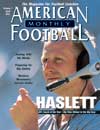AMERICAN FOOTBALL MONTHLY THE #1 RESOURCE FOR FOOTBALL COACHES
Article CategoriesAFM Magazine
|
Just for KicksAn often overlooked part of the game, consistently good punt returns can carry teams to the winner\'s circleby: Paul McCord Special teams coordinator, Western Maryland College © More from this issue The punt return means big play time for us. Players at Western Maryland pay special attention to this part of the game. We have had success blocking punts and we have returned punts for touchdowns multiple times over the past four seasons. More importantly, we make things happen on every punt return and have an opportunity to score. Statistically, having a return average of 10 yards or more is important, but the goal should be to accumulate yardage consistently on each return. Put Pressure On As Many Punts As Possible We have won every game where we have blocked a punt and we score 100 percent of the time following a block. As Virginia Tech has shown, an effective punt block unit can be a lethal weapon and can deflate a team's morale We apply pressure to each punt to prevent coverage from releasing. The longer we force....The full article can only be seen by subscribers.
|
|
|||||||
| HOME |
MAGAZINE |
SUBSCRIBE | ONLINE COLUMNISTS | COACHING VIDEOS |
Copyright 2025, AmericanFootballMonthly.com
All Rights Reserved





